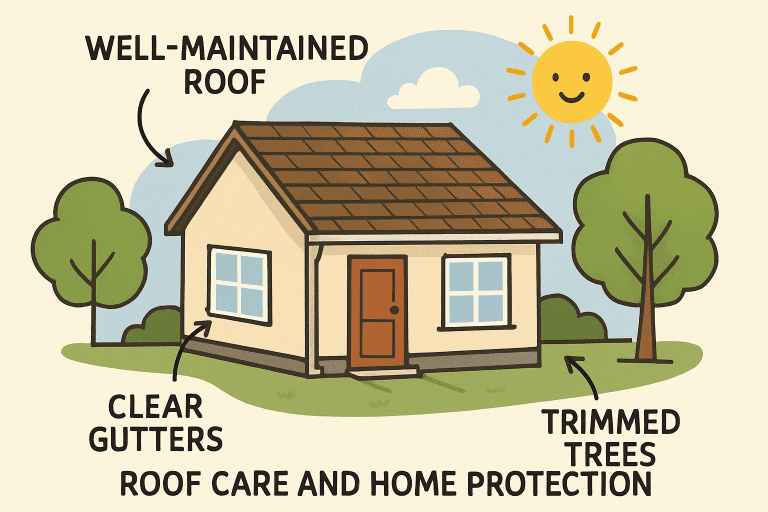Creative Strategies for Homeowners to Extend Roof Longevity

Key Takeaways:
- Regular maintenance and proactive measures can significantly extend roof longevity.
- Implementing energy-efficient upgrades not only protects your roof but also helps reduce your utility costs.
- Understanding and addressing common roofing issues promptly prevents costly repairs.
Staying ahead of roof maintenance pays dividends for homeowners hoping to avoid leaks, costly repairs, and premature replacement. Every homeowner faces unique roofing challenges, from seasonal ice dams to the harsh sun of the Midwest. Through a strategic combination of proactive care and thoughtful upgrades, it’s possible to get the most out of your roofing system year after year. If you’re uncertain where to begin or need professional insight, a roofing contractor in Chicago can offer tailored guidance for your specific property and climate conditions.
Each roofing decision—whether involving inspection frequency, material selection, or preventive measures—impacts longevity and overall home value. By embracing smart maintenance routines and knowing when professional help is needed, even older roofs can regain their vitality. Ultimately, this proactive mindset preserves both the roof’s function and its curb appeal.
The following strategies and upgrades help homeowners extend the life of their roof while protecting the structural soundness of their home. From seasonal checks to high-tech rejuvenation services, these tips offer actionable pathways for every type of property and budget.

Regular Inspections: The First Line of Defense
Annual and seasonal roof inspections stand as your best protection against sudden and expensive complications. Missing or cracked shingles, broken flashing, and minor leaks can be easy to overlook from the ground, but they can worsen quickly under rain and snow. For enhanced safety and accuracy, homeowners are turning to drone-assisted inspections that deliver detailed reports without the need for ladders or risk to personal safety. This early-warning system helps treat issues while they remain affordable—sometimes saving thousands in unexpected repairs.
Gutter Maintenance: Preventing Water Damage
Debris-filled gutters can quickly create expensive headaches, ranging from attic leaks to soaked insulation and foundation problems. Twice-yearly cleaning, ideally after leaf fall and in early spring, ensures rainwater drains effectively off your roof and away from your house. Gutter guards provide an extra layer of protection for homes surrounded by mature trees, reducing the maintenance effort required. Additionally, ensure that downspouts extend several feet from your home’s foundation to prevent pooling and erosion.
Attic Ventilation: Balancing Temperature and Moisture
Temperature and humidity levels within your attic directly affect the structural health of your roof. Without proper ventilation, the summer sun can drive up attic heat, warping shingles and causing roof sheathing to deteriorate. In winter, trapped moisture leads to mold growth and potential rot. Ensuring balanced intake and exhaust vents allows fresh air to circulate, minimizing heat buildup and condensation. A well-ventilated attic even helps lower energy bills and reduce ice dam formation.
Protective Coatings: Shielding Against the Elements
Roof coatings serve as a protective layer, enhancing weather resistance and extending a roof’s overall lifespan. These treatments are particularly valuable for roofs facing constant sun, heavy rains, or ice. Not all roof types require sealant, but stone, slate, and metal surfaces particularly benefit from the extra defense. Certified roofers can assess your needs and reapply coatings as needed to maximize both performance and visual appeal. The relatively modest investment in coatings pays off by deferring the need for full roof replacement.
Tree Trimming: Minimizing Physical Damage
Mature trees add beauty to your property, but overhanging limbs are a serious threat to your roof’s integrity. Branches can scrape, puncture shingles, or drop leaves and debris into your gutters. Trim branches back at least 6-10 feet from the roofline to prevent abrasion and reduce leaf accumulation. It’s also wise to remove dead or unstable limbs periodically to prevent them from falling during storms or under the weight of snow.
Energy-Efficient Upgrades: Enhancing Roof Performance
Modern roofing materials that reflect heat, such as cool roofs or metal panels, protect from UV rays and reduce the strain on your attic. Not only do these upgrades improve comfort and lower cooling bills, but they also stand up better against temperature extremes than standard asphalt shingles. If you live in a particularly sunny or warm region, investigating energy-efficient roofing options can pay for itself over time through reduced utility costs and fewer repairs.
Prompt Repairs: Addressing Issues Before They Escalate
At the first sign of damage—whether it’s a split shingle, minor leak, or damaged flashing—take action. Water will exploit even the smallest vulnerabilities, potentially leading to widespread decay and interior mold. Early repairs keep problems localized and inexpensive, greatly reducing the chance of more severe and costly roof failures in the future.
Professional Rejuvenation: Restoring Roof Vitality
For roofs showing signs of aging but not yet due for replacement, roof rejuvenation services offer an eco-friendly solution. Treatments using bio-based oils replenish dried-out asphalt shingles, restoring their flexibility and waterproofing properties. This service can prolong a roof’s useful life by several years, staving off the much larger investment of a new roof installation while improving energy efficiency and appearance.

